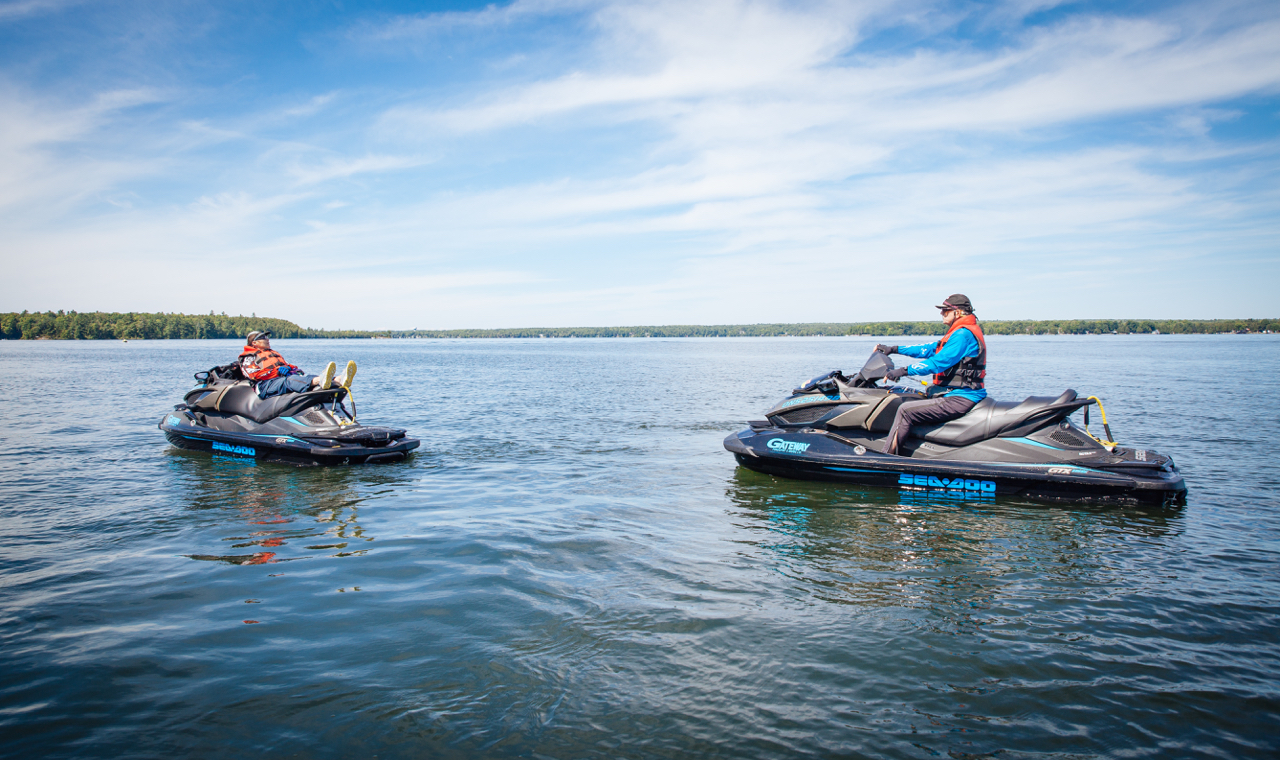Theft Prevention Tips For Jet Ski Riders…
Related: DESS Anti-Theft Key Re-Invented
Here are my Top 5 Sea Doo Anti Theft Tips for Sea Doo tours by experienced jet ski riders or PWC beginners. I don’t hear much chatter about jet ski theft. Maybe PWC thieves can’t swim. But being such a trusting sole, I always lock up my two Sea Doo watercraft when not on a PWC adventure. Same goes for my Triton trailer…
Types Of Theft
There are two basic types of personal watercraft theft. One is by thieves looking for an easy joy ride or to make a quick buck. Generally, these lowlifes aren’t as well organized, look for targets of opportunity, and likely aren’t well-equipped to deal with good ant-theft measures. Unfortunately, the other type is by organized theft rings who are very serious about their business and expert in handling even the best anti-theft devices.
So there’s no such thing as theft proof. But that doesn’t mean you shouldn’t make your PWC(s) as hard as possible to steal. In the event of theft, your insurer will be much more accommodating to your loss claim if you provide photos of your regular anti-theft measures to prevent their being stolen. In fact, many marine policies contain small print that requires the owner to lock the insured items when not in use or for off-season storage.
Other Sea Doo Anti Theft Considerations
Cover Up
Personal watercraft trailers are not enclosed, so everyone can see what’s up for grabs. There’s some deterrence in simply covering your jet skis against prying eyes. Covering them both with one large tarp may make them less obvious and also protect from the elements. Alternatively, you can use individual generic covers to help disguise what brand and models they are. But an expensive manufacturer cover may actually get stolen if it isn’t also locked on to the unit somehow. And it certainly is more likely to catch thief’s eye.
Single vs Multiple Targets
Obviously, locking two PWCs sitting on a 2-bed trailer is more challenging than securing one on a single. And merely locking the jet skis to the trailer doesn’t help much if thieves can just drive off with your whole rig.
But a small crew doesn’t even have to steal your whole rig. They can lift a jet ski off your trailer and into the bed of a pick-up with too much effort. So everything has to be locked to everything else, and then the trailer either immobilized with locks or fastened to a ground anchor. Or preferably both.
Remove Your Gear
Another point to consider is removing valuable accessories and items in storage compartments when your personal watercraft are parked on your trailer or moored at dock overnight. And certainly for off-season storage. First off, light-fingered trouble makers may be tempted to steal miscellaneous gear left on board. Second, if your jet skis do disappear, these articles may complicate your claim, and be an expensive pain to replace. They might not even be covered under your marine policy.
Security Galore

Wheel lock on trailer tire + cable locking PWC to trailer.
There’s no such thing as a cheap good lock. And even the good ones come in varying degrees of tamper proofness. I shop for my locks, cables and chains from companies who handle heavy duty equipment and industrial security needs. For coupler and wheel locks, I prefer to shop at a store specializing in trailer accessories and service rather than at a big box store.
Look for brands like Abus, Kryptonite or Master Lock, and buy weather resistant locks with cut-proof, hardened steel shackles, protected hasps, strong tensile resistance. I ended up with a pile of locks and keys, but keeping them sorted is just a matter of being organized.
Various motion sensor alarms and tracking devices are also available for your jet skis. Frankly, I don’t use any because I’ve had some frustrating experience with false motion alarms. But if you’re parking your rig at home, installing an alarm is probably a good idea.
As to tracking devices, SPOT Trace is a good one. But I tend to view tracking devices as proof of my own failure to actually prevent the theft. Both alarms and tracking devices require battery power that can fail, especially during long storage periods or in cold temps. Also, connecting one (or both) directly to your PWC battery can drain it to the point of not enough charge left to start your engine when you launch for your next ride!
With all that said, here are my Top 5 Sea Doo Anti Theft Tips…
Sea Doo Anti Theft Tip #1. Buy A Sea-Doo…
No doubt, Sea-Doo’s Digitally Encoded Security System (DESS) is a great built-in, anti-theft device. The Sea-Doo “key” is computer coded specially for each unit. Without the proper DESS, the unit won’t start, which certainly discourages opportunist joy-riders.
Sea Doo Anti Theft Tip #2. Lock to Dock…
Any time I leave my jet skis at a dock out of sight or overnight, I fasten them to the dock and to each other with a Lock Strap or other cable lock. Although primarily designed as a trailer tie down, the Lock Strap has an integrated theft deterrent cable. It’s also flexible, light to carry, and hooks up easily. And its combination lock eliminates any chance of dropping a key overboard.
Sea Doo Anti Theft Tip #3. Lock on Trailer…
Whenever my two Sea-Doo watercraft are aboard my Triton PWC trailer, I secure them to each other with several Lock Straps. Then I add top quality cable locks, long enough to go through the each of front and rear metal brackets on my Sea Doo watercraft and around a part of the trailer frame. I don’t tow with these locks in place to keep them, clean and dry.
Sea Doo Anti Theft Tip #4. Lock Trailer Coupler…
Instead of using the provided clip or bolt to fasten the coupler lever closed, I use a high quality lock. It not only prevents the lever from accidentally releasing the coupler from the hitch ball in transit. A thief will also find it more difficult to steal the jet skis while loaded on the trailer. For the same reason, my removable hitch is always locked on to my tow vehicle. Then I add a coupler lock that fits into the space where the coupler drops onto the tow vehicle hitch ball, and wrap the safety chains tight around the trailer tongue and lock them together to reduce the chance of their being used to pull the trailer.

PWCs on trailer chained to fence. Unfortunately, the Steal Shield on the coupler is not made anymore.
Sea Doo Anti Theft Tip #5. Secure Parking…
If my jet skis are sitting idle on the trailer for a few days unattended and not hitched to my tow vehicle, I try to park in a well-lit area with the trailer backed in tight between other vehicles with the rear against something solid like a concrete wall. I figure the less space there is around my rig for thieves to get access, the more difficult it will be to do their dirty work. I also secure one trailer wheel with a wheel lock. I’ve even heard of some guys removing one trailer wheel entirely and leaving it jacked up while parked.
Since I live in a city with limited parking at home, I store them between use during the season in a gated, restricted access, outdoor rental space with security cameras. The facility let me install a security ground anchor at the rear and I always lock onto it with a heavy duty chain and padlock.
Off-season, I pay my dealer for a winterizing and storage package where my beauties sit securely inside all winter.
My Last Word
There is no sure-fire way to stop theft by determined criminals. But taking regular precautions can certainly reduce your odds of being a theft victim. And of having your season ruined by losing your perhaps immediately irreplaceable PWCs. As they say, I don’t have to make my personal watercraft totally theft-proof. Mine just need to be harder to steal than the ones next to it! But here’s one tip if they do go missing: for easier identification on recovery, etch your initials or other ID info somewhere out of sight in the engine area.
If you enjoyed this post, check out my other riding tips.
The tips and advice in this article are the opinions of the author, may not work in every situation and are intended only for the convenience and interest of the reader, who has the personal responsibility to confirm the validity, accuracy and relevancy of this information prior to putting it to their own use.

